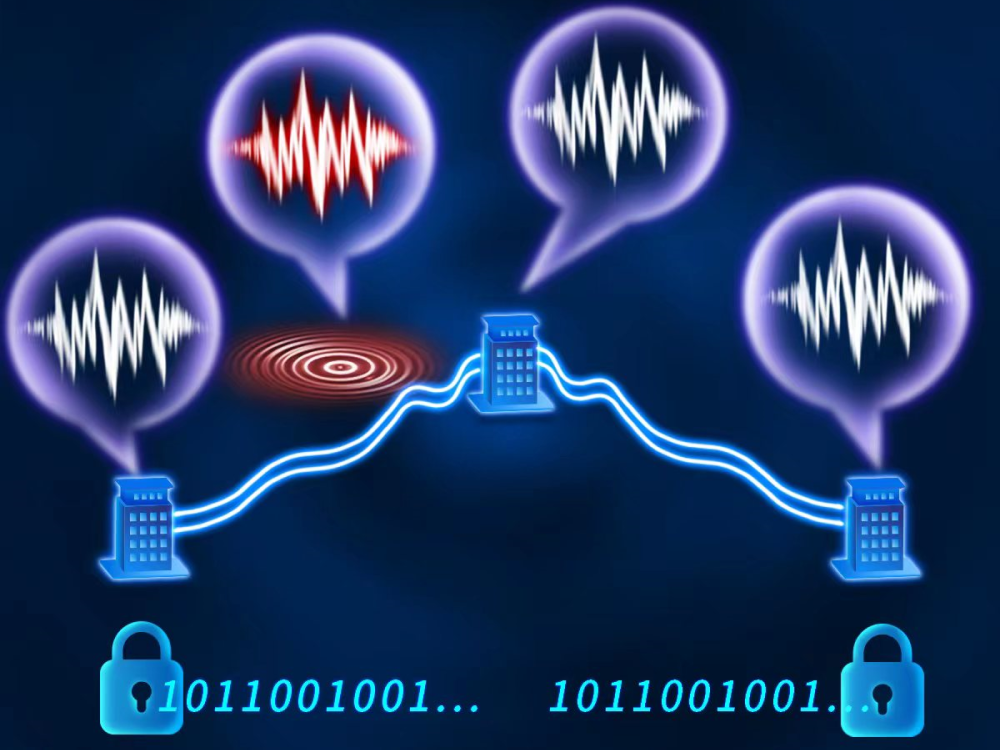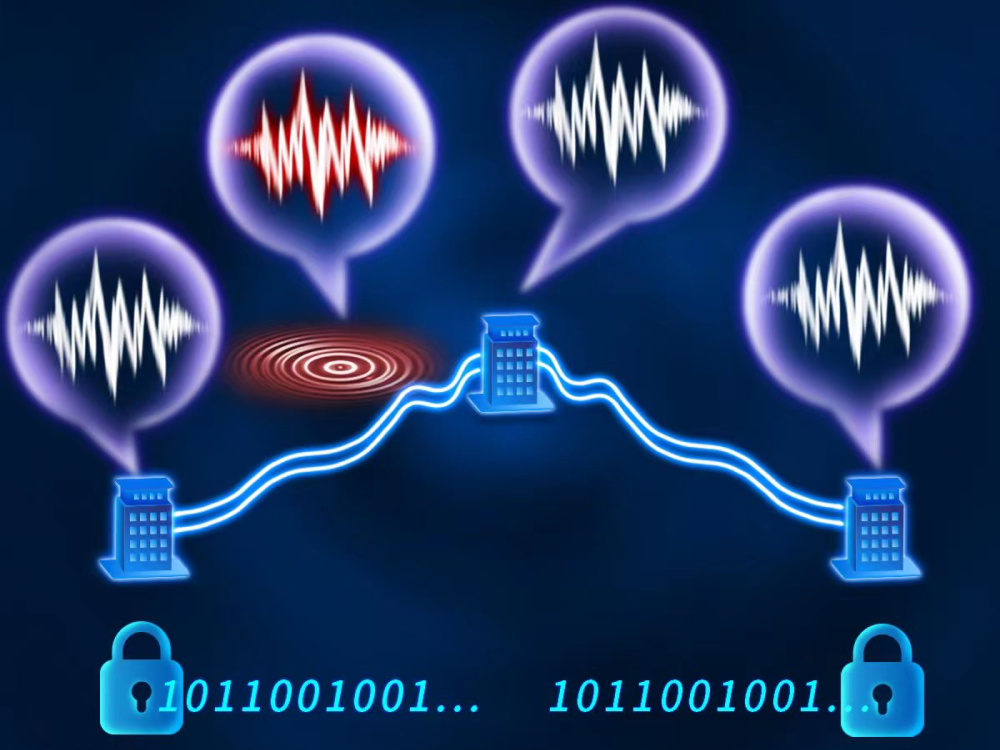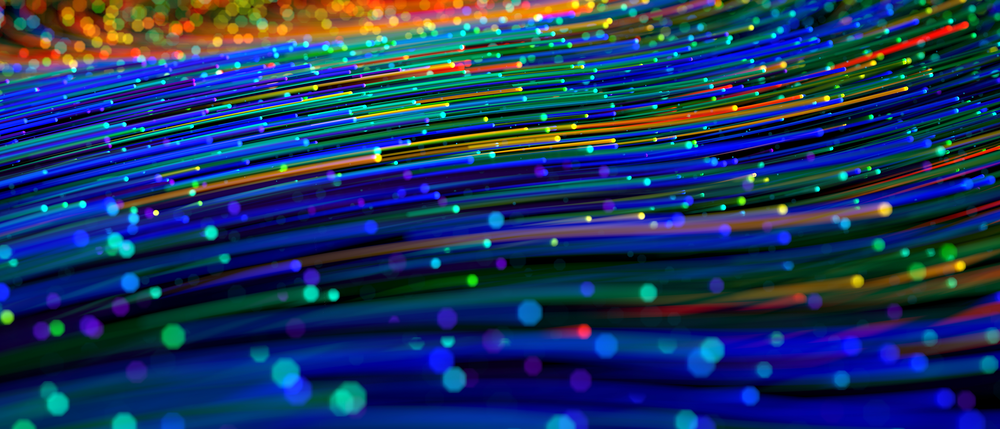Seismic Sensing Using Quantum Cryptography Network
One form of quantum cryptography involves an optical fiber network over which users share encryption keys—strings of bits used to encode and decode messages. Fiber networks can also be used to sense earthquakes, and now researchers have shown that the two tasks could be combined [1]. The team sent a quantum key distribution (QKD) signal over a 658-km-long fiber while causing the fiber to vibrate at a specific location. They detected this vibration via the optical signal and showed that they could determine its position to within 1 km. The new technique could potentially piggyback on QKD networks currently being set up in China, South Korea, and other countries.
QKD researchers are developing techniques for sending keys over optical fibers and through wireless technologies. A common fiber protocol, called twin-field quantum key distribution (TF-QKD), obtains secure, long-distance encryption using photon interference. Detecting that interference requires constant monitoring of the light signals that users share across each fiber link. Jiu-Peng Chen from the University of Science and Technology of China and his colleagues realized that they could use this continuous data stream to detect vibrations along the fiber. “We demonstrated the possibility to collect vibration sensing data without adding new fiber or hardware resources to a TF-QKD network,” says team member Qiang Zhang.
A TF-QKD experiment consists of two optical setups—called Alice and Bob—at opposite ends of an optical fiber. Each setup generates a random string of bits and sends it as an optical signal over the fiber to an intermediate node called Charlie. At Charlie, the two signals interfere, and the resulting optical signals are then transmitted back to Alice and Bob, who use the interference outcomes to generate a shared key.
Zhang and colleagues demonstrated TF-QKD in a lab setting with optical fiber wrapped around spools. The total fiber length of 658 km was one of the longest fiber-based QKD demonstrations to date (a recent experiment reached 834 km [2]). Using this fiber link, the team explored the vibrational signatures hidden in their data. As is common for the TF-QKD method, Zhang and colleagues designed their system to correct for fluctuations in the phase of light passing through the fiber. For example, if a sudden movement briefly extends the length of Alice’s fiber by a half wavelength (equal to a phase fluctuation of 𝜋 radians), a trough of the light wave would arrive at Charlie instead of a peak. So a TF-QKD system must continuously make adjustments—such as stretching the length of fiber by incremental amounts—to cancel out phase fluctuations. “We have spent a major effort to compensate the phase fluctuation in the channel while building our TF-QKD system,” Zhang says.
The team showed that this fluctuation-compensation system can be used to detect a seismic vibration by installing a piezoelectric device that wiggled Alice’s fiber at a specific location. The vibration frequency was set between 1 and 1000 Hz, which is the relevant range for seismic sensing. The vibrations produced phase changes between 0.9 and 50 radians, which the fluctuation-compensation system picked up. Zhang says that seismic waves should produce much larger phase changes, in the range of several hundred to several thousand radians [3]. The team performed a similar test on the frequency calibration link—a separate fiber that is required by TF-QKD systems to lock the frequencies of Alice’s and Bob’s lasers together. The researchers used this link to pinpoint the location of the vibration source with a precision of 1 km.
“Detecting vibration at such a long distance is impressive,” says quantum information expert Hoi-Kwong Lo from the University of Toronto. He notes that similar techniques have been developed to sense vibrations along optical fibers, such as a recent experiment that used underwater telecommunication fibers to detect earthquakes [3]. One of the authors of that paper, Giuseppe Marra from the National Physical Laboratory in the UK, says that the new QKD demonstration follows the same concept as his and other previous work. “Future QKD links based on this technique could provide useful additional seismic information from installed fibers,” he says.
–Michael Schirber
Michael Schirber is a Corresponding Editor for Physics Magazine based in Lyon, France.
References
- J.-P. Chen, “Quantum key distribution over 658 km fiber with distributed vibration sensing,” Phys. Rev. Lett. 128, 180502 (2022).
- S. Wang et al., “Twin-field quantum key distribution over 830-km fibre,” Nat. Photon. 16, 154 (2022).
- G. Marra et al., “Ultrastable laser interferometry for earthquake detection with terrestrial and submarine cables,” Science 361, 486 (2018).






